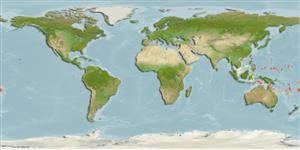Common names from other countries
>
Perciformes/Serranoidei (Groupers) >
Grammistidae (Soapfishes)
Etymology: Pseudogramma: Greek, pseudes = false + Greek, gramma = letter, signal (Ref. 45335); pectoralis: Named for its having the longest pectoral fins of the species of the genus and being one of 2 species with only 13 pectoral rays..
More on authors: Randall & Baldwin.
Environment: milieu / climate zone / depth range / distribution range
Ecologie
marien rifbewoner; diepte 20 - 52 m (Ref. 27020). Tropical
Western Central Pacific: Palau and the Philippines.
Grootte / Gewicht / Leeftijd
Maturity: Lm ? range ? - 3.6 cm
Max length : 3.6 cm SL (female)
Dorsale stekels (totaal) : 7; Dorsale zachte stralen (totaal) : 21 - 23; Anale stekels: 3; Anale zachte stralen: 18 - 19; Wervels: 26. Body yellow with a faint brown reticulum, shading to pinkish white on abdomen and thorax; fins yellow. Head pale pink. Opercle with an ocellated black spot as large as the eye. A blackish red stripe, edged in pale pink and red, from eye to opercular spot. No dermal flap or small tentacle dorsally on eye. Long tubular anterior nostril at front of snout; when laid back not reaching posterior nostril. Lateral line incomplete. Longitudinal scale series 52-53. Snout length 5-5.1 in head. Caudal-peduncle depth 3.1-3.2 in head; short length 6.2 in head. Pectoral fins long, 2.65-2.85 in SL (Ref. 27020).
Cryptic (Ref 90102).
Levenscyclus en paargedrag
Maturities | Voortplanting | Spawnings | Egg(s) | Fecundities | Larven
Randall, J.E. and C.C. Baldwin, 1997. Revision of the serranid fishes of the subtribe Pseudogrammina, with descriptions of five new species. Indo-Pac. Fish. (26):56 p. (Ref. 27020)
Status op de Rode Lijst van het IUCN (Ref. 130435)
CITES (Ref. 128078)
Not Evaluated
Gevaar voor de mens
Harmless
Gebruik door de mens
Visserij: van geen belang
Tools
Speciale rapporten
Download XML
Internetbronnen
Estimates based on models
Preferred temperature (Ref.
115969): 25.9 - 28.7, mean 27.1 (based on 34 cells).
Fylogenetische diversiteitsindex (Ref.
82804): PD
50 = 0.5001 [Uniqueness, from 0.5 = low to 2.0 = high].
Bayesian length-weight: a=0.00427 (0.00166 - 0.01096), b=3.17 (2.94 - 3.40), in cm Total Length, based on LWR estimates for this (Sub)family-body shape (Ref.
93245).
Trofisch niveau (Ref.
69278): 3.3 ±0.5 se; based on size and trophs of closest relatives
Fishing Vulnerability (Ref.
59153): Low vulnerability (10 of 100).
